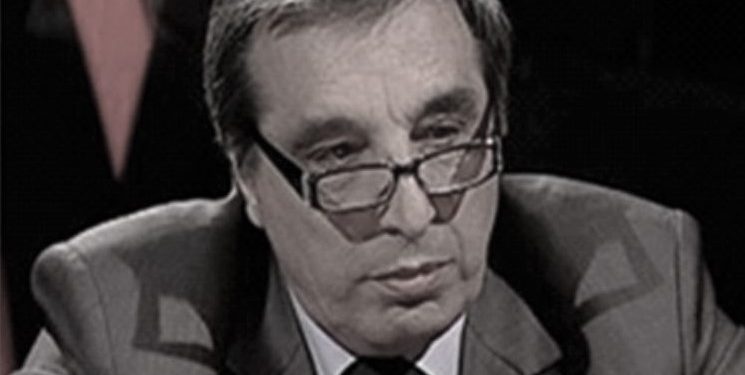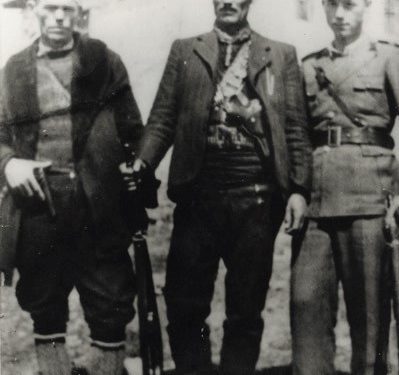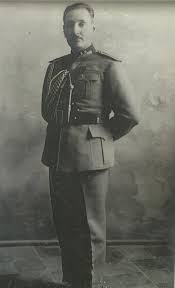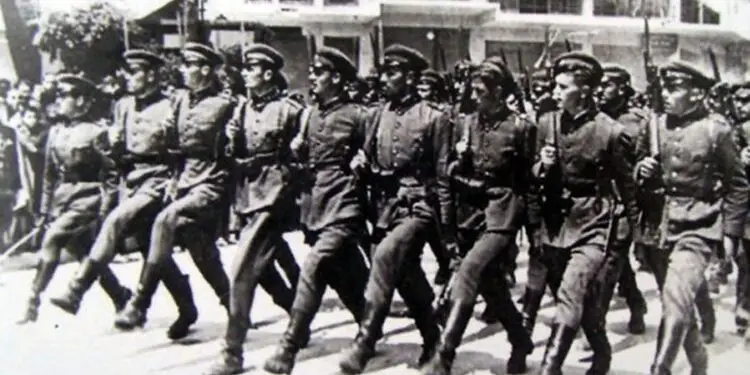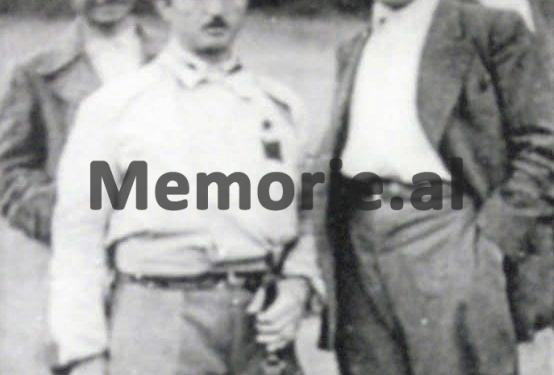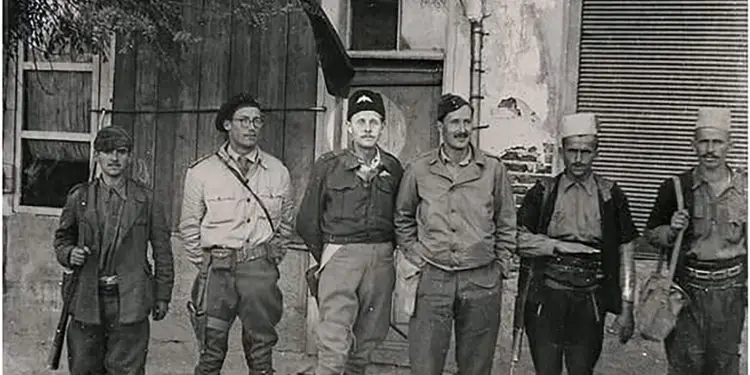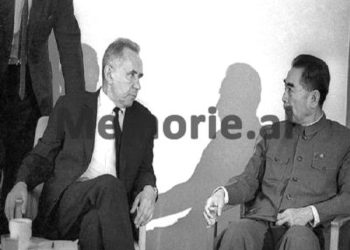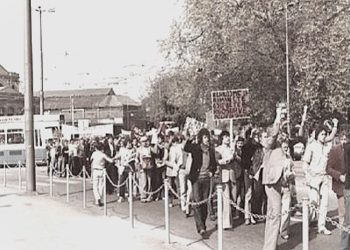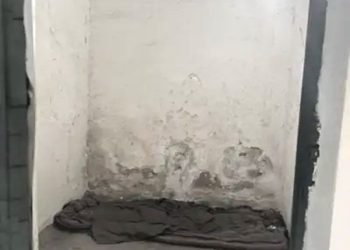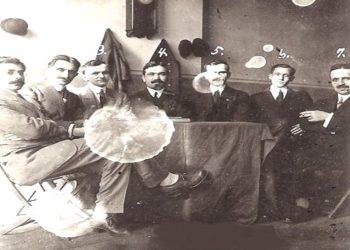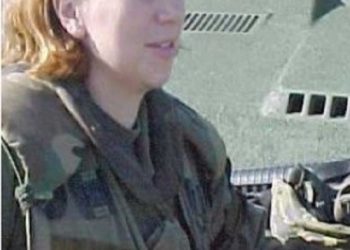By Qerim LITA and Halim PURELLKU
Second part
Memorie.al / On May 10, 1941, under the leadership of the Albanian Committee in Skopje, a large anti-Bulgarian demonstration was organized. Hundreds of Albanian demonstrators, with white pleats on their heads, were gathered and holding placards that read: “Skopje of the Albanians”. The professors and students of the “Gazi Isa Bey” Madrasa joined the crowd. According to Bulgarian police information, this crowd was led by Bedri Hamiti. In contrast to the Italian occupation area, the Albanian population in the Bulgarian occupation area was in a very difficult social, political, economic and cultural position.
Continues from last issue
Albanians here, not only were not recognized with national rights, but also with political and civil rights. By the Bulgarian government, the Albanians were treated as a dangerous element for the Bulgarian interests, therefore, under the pretext of searching for weapons, the Bulgarian military-police forces exercised violence and terror in many Albanian villages, killing, beating, looting the Albanian population which, unable to defend him, he had been forced to retreat to safer places.
The Bulgarian violence and terror against the innocent Albanian population encouraged a part of the then Albanian intelligentsia to take serious and concrete measures for the political organization of the Albanians under the Bulgarian occupation. This idea was expressed in the meeting held on April 19, 1941, in the premises of Bojali Hani in Skopje, with the participation of; Shaban Jasharit from Kumanova, Aqif Tetova from Gjilan, Shaip Mustafa from Presheva, Jahja Osmani from Kumanova, Abdulla Veliu from Presheva, Hafëz Lutfi Ahmeti from Presheva, Abdulla Sakipi from Presheva (with residence in Skopje) and Idriz Ymeri-Cërcëri, from Tetova.
According to Yugoslav secret sources, it turns out that at that meeting; the Albanian Committee was founded, named “Movement for Liberation and Union”, which would commit itself to the Albanian territories of Skopje, Kumanovo and Presheva, joining Albania.
THE BALKANS DURING WORLD WAR II
When the Skopje Committee was developing intense political activities, among the Albanian population that was under the Bulgarian occupation, the Italian army entered Tetovo. This meant that this city would now be annexed to Albania, therefore the Albanian population of Pollog, under the leadership of Shaip Kamberi, Xhafer Sulejmani, Idriz Cërcër, etc., gave a magnificent reception to the Italian army and Albanian intellectuals, who were sent from Tirana to, together with the local intelligence, organize the Albanian administration in the City Hall of this city.
The placement of the Albanian administration in Tetovo enthused the leaders of the Movement even more. Now it spread throughout the Albanian space, outside of political Albania, and developed a dense activity. Especially this activity was noticed in the Albanian regions, under the Bulgarian occupation.
In the villages of Karadak, Derven, Karshijaka, Kaçanik, etc., even in the cities of these provinces, such as; In Skopje, Kumanovo, Preshevo, Gjilan, Kaçanik, etc., the Albanians, in a massive way, removed the black turbans and caps, replacing them with white pleats. The Albanian leaders, scattered throughout all those provinces, asked for unity and determination, because “only in this way could the nationwide union be reached”.
This activity was also noticed by the Bulgarian police, who announced that: “..individuals of Albanian nationality, supplied with open leaflets, visited the largest cities in Macedonia, to develop propaganda, during which they took white pleats themselves, which they distributed among the Muslim population in the city of Skopje and in other larger cities, in order to present the situation to the German authorities, that the dominant element in those cities are the Albanians”!
On May 10, 1941, under the leadership of the Albanian Committee, a large anti-Bulgarian demonstration was organized in Skopje. Hundreds of Albanian demonstrators, with white pleats on their heads, were gathered and holding placards that read: “Skopje of the Albanians”. The professors and students of the “Gazi Isa Bey” Madrasa joined the crowd. According to Bulgarian police information, this crowd was led by Bedri Hamiti. Demonstrators from “Bojali Hani” paraded through the old Bazaar of Skopje, in front of the Bulgarian military command, the German General Staff and the Italian consulate.
Immediately after these demonstrations, the Bulgarian authorities blamed the Italian consulate in Skopje, that it; “was behind this organization”. It was also emphasized that, “from the research so far, related to the propaganda and against the Italian intelligence in the city, it has been proven that the most active are: Hamit Kokolari – consul for the Albanian population, who has many connections among the Albanians and Aldo Mortani – translator at the consulate, who was born in Skopje and has connections with all layers of society”. These two, continued the announcement of the Bulgarian police; “they implement Italian propaganda among the local Albanian population, but they also propagate in another part of the population”.
The Bulgarian authorities were especially concerned that the city of Skopje was filled with white people, which ultimately exposed the entire Bulgarian propaganda, supposedly; “Albanians in this city were an insignificant minority”, and that the majority of the Muslim population; “they were of Turkish nationality”!
The Bulgarian police and military authorities, immediately after these demonstrations, undertook a brutal and violent action against the Albanian population. The Bulgarian violence and terror against the defenseless Albanians was described by the member of the Kosovo Committee, Ramadan Presheva, who on May 20, 1941, in detail, informed the High Civil Commissariat for Kosovo, Dibër and Struga. After the severe reaction of the Albanian Government to the Italian authorities, this violence was temporarily stopped, only to continue again during the years 1942-1943.
At the beginning of 1942, the local Bulgarian authorities in the wider region of Presheva resumed terror against the Albanian civilian population, both in the city and in the villages. This terror was carried out, both by the Bulgarian police forces and by the Slavic gangs operating in this area, with the aim of forcing the Albanians to move, since they constituted over 70% of the total population of the municipality.
EXTENSION OF CONNECTION II OF PRIZREN IN THE EASTERN TERRITORIES
A few days after the capitulation of Fascist Italy (September 8, 1943), in Prizren, on September 16-21, 1943, the “II Connection of Prizren” was founded, in which delegates from the provinces of Eastern Albania were: Mentor Çoku from Struga, Rustem Imeri and Shahin Cami from Dibra, Ahmet Lusha, Jusuf Jahja from Tetova, Remzi Ragipi and Kadri Saliu from Gostivar, Shefqet Skopje and Haxhi Xheladini from Skopje.
Among the most important decisions of the Congress were: “Demand for permanent and indissoluble union of all the provinces inhabited since a thousand years, by the Albanian population; The general vote of all the delegates represents the will of the entire population of these provinces, which takes the place of a popular plebiscite for this union. Therefore, we request the worldwide announcement of this holy will of the inhabitants of Kosovo, Dibra and Struga, with Albania; formation of the Central Committee with headquarters in Prizren.
The Central Committee should open its branches in all prefectures, sub-prefectures and municipalities of the provinces of Kosovo, Dibra and Struga, which will take over the military and political organization of Kosovo; the collection of all historical, political and diplomatic documents, which strengthen the Albanian existence of the Free Lands, as well as the endless events and sufferings of the inhabitants of these villages, during the Yugoslav rule, as a document in case of a future peace…. etc.”.
While in Prizren the Congress of the “2nd Connection of Prizren” was taking place, on the initiative of Kadri Saliu and Shuaip Kamberi, the Albanian nationalist leaders were called to Gostivar, to familiarize themselves with the decisions made in the National Assembly, held in Tirana, as well as for the establishment of the “II Connection of Prizren”. Participating in this meeting were the intellectual and nationalist leaders of these villages such as: Xheme Gostivari, Aqif Reçani, Xhevat Kallajxhiu, Shuaip Kamberi, Kadri Saliu, Xhafer Sulejman Tetova, Mefail Zajazi, Gajur bey Deralla, as well as the leaders of Luma; Muharrem Bajraktari, Osman Lita, Zyber Lita. etc.
In the meeting, among other things, it was decided that Gajur Derralla would establish the Albanian battalion in Tetovo, which would be considered as a regular unit of the Albanian Government Army. It wasn’t long before the General Command of the Albanian National Army appointed Gajur Derralla, commander of the Tetova Battalion, while Arif Dragomanci and Memish Bukoviqi were appointed as his deputies, who at the same time were commanders of the detachments. In addition to the battalion, the District Committee of the “II Connection of Prizren” was founded, based in Tetovo, as well as the district committees: Gostivar, Kîrçovo, Dibër and Struga.
In a Macedonian UDB document, the plans and goals of the committees and the battalion were described in detail. According to her: “The committees and the battalion will operate outside the state system, they will carry out activities according to the desire and will of the Albanian majority people from these countries, for the preservation of the integrity of Albania and will oppose the decisions of the Yalta conferences , Moscow, etc., in which Yugoslavia was guaranteed its previous borders”.
In addition to the above battalion, Albanian volunteer military units were also established in these areas, known as “Kreshnik forces”. The general commander of these forces was the well-known Albanian soldier and patriot Xheme Gostivari, while his deputy was Mefail Zajazi. Later, after the capitulation of Bulgaria, these forces were also spread over the wide region of Derven in Skopje, as well as in the field of Kumanovo, and were commanded by Sulë Hotla and his two deputies: Abdyl Durra and Memish Bukoviqi.
THE “DIBRAN UNION” COMMITTEE AND POLITICAL-MILITARY DEVELOPMENTS IN DIBAR, JULY-NOVEMBER 1943
In the spring of 1943, the Albanian nationalist leaders operating in the province of Dibra and Luma held several secret meetings, which aimed to create a patriotic movement that would undertake the organization of a general anti-fascist uprising in the Albanian lands.
Regarding these movements, the General Directorate of the Albanian Police, on August 1, 1943, informed the Minister of Internal Affairs that: “Recently, a union of interests has been created between Cen Elez, Muharrem Bajraktar, Myftar Kaloshi, Ali Maliqi of Councilor Epruer, Fiqiri Dine, in order to reduce the population within a short period of time, against the current situation”.
It was further said that; they have agreed that this alliance should be extended to other centers as well, for which: “the first two should teach Prizren, the other three Dibra and Peshkopi”. The leaders of this movement called on the leadership of the KPSH district of Dibra to join this group for a coordinated action, but it refused, stating that it would act; “only according to the instructions that would be given from its center”. Nevertheless, the Dibra nationalists organized several meetings, with Haxhi and Aqif Lleshi, in Maqellare and Homesh, but without any results.
On the contrary, the Ministry of the Interior concluded that; “It shows a tightening of relations between the Nationalist Party and the Communist Party”, adding that; “The goal of the Nationalist Party is to work in peace and to prepare for the eventual landing of the Anglo-American powers in the Balkans, to begin its action against the Axis powers. Until that time, which they hope will be near, to prepare the people morally and materially for the fight”.
As a result, the “Bashkimi Dibran” Committee was formed, chaired by Hysni Dema. Among the other, more well-known leaders who joined the committee were: Fiqiri Dine, Riza Drini, Miftar Kaloshi, Halil Alia, Ali Maliqi, Fik Maliqi, Uke Cami, Cen Elezi, etc. The committee, as it was named, aimed at uniting all Albanian leaders in the province of Dibra, regardless of their ideology. Based on this, the leaders of the committee held several more meetings with Aqif and Haxhi Lleshi and, as a result, on August 2, 1943, a joint headquarters was formed between the “Bashkimi Dibran” Committee and the partisans operating in Dibër.
Regarding the formation of the joint headquarters, Sotir Vullkani in his report, sent to the General Headquarters of the LNCSH, stated: “Before Zerqani was taken, we reached an agreement with the party, where a kind of headquarters was formed; in order to we cooperate in the war against the occupier. The headquarters consisted of; Fiqiri Dines, Hysni Demës and Esat Ndreut”.
This staff, right from the beginning, encountered disagreements. The nationalist wing “Bashkimi Dibran” demanded that the united Albanian forces declare the entire province of Dibra a free zone, including Dibra e Madhe and Peshkopina, while Esat Ndreu, who represented the National Liberation Front, demanded that the free zone Peshkopia and its surrounding provinces were announced, without including Great Dibra.
With the insistence of the nationalists, the partisan forces (which at that time were several times smaller than the nationalist forces), were forced to participate in the liberation of Dibra (September 8, 1943). Sotir Vullkani, in the above-mentioned report, emphasized: “We, in order to take action against the occupier, agreed to fall to Dibra as well, despite the fact that we had not yet organized work among the other countries, which we were leaving behind “.
Immediately after the liberation of the city of Dibra, the Albanian government was established, consisting of two wings, the nationalist and the communist. This policy was unacceptable to the Yugoslav communists, therefore Tempo, on October 1, 1943, sent a letter to Haxhi Lleshi, asking him to: “Take strict measures against the Albanian-Madh reaction”, because according to him: “this reaction in Dibër is also reflected in Kîçovo”.
He suggested to his friend that, if possible, cause “division between them, taking advantage (doing it for himself), one of them, always taking into account that immediately, start propaganda for the labeling of others”. Tempo demanded that Haxhi Lleshi create in Dibër a “new Dibra battalion, with mixed Albanian-Macedonian soldiers, where, in addition to the Albanian flag, the Yugoslav flag will also fly”. All this had to be done in the spirit of “fraternity – unity”.
Tempo specified that; “the new government that will be established should be headed by a communist government, the battalion should be led by the Slavo-Macedonians and the local Albanians”, as well as to strictly implement the agreement signed between the General Staff of the Albanian National Liberation War and the of the National-Liberation War of Macedonia, according to which: “all Albanian territories, which were united with Albania from 1941, were counted as Macedonian territories”, therefore Macedonian power had to be established in those territories.
MEETING WITH CEN ELEZIN, XHETAN E BESHIR NDREU
In accordance with Tempo’s request, Haxhi Lleshi organized a secret meeting with the heads of the Ndreu family, namely Cen Elez, Xhetan and Beshir Ndreu, who he asked to abandon the “Dibran Union” Committee and join the forces of the Front National Liberation of Albania.
At the same time, Haxhi Lleshi asked Cen Elez, that the gendarmerie merge into the “National Liberation Army” or, with “his gangs and comrades” and commit all forces to war, closely cooperating with the neighboring forces of the National-Liberation War of Macedonia, while the solution of the issue of borders, should be left to: “The Atlantic Charter and the Treaty of London”.
The meeting ended without any conclusion. Cen Elezit gave you 24 hours to consult with the members of the Committee. The next day, Cen Elezi, affirmed that he would enter the war, as soon as the depots were handed over, he did not accept the distribution of the carabinieri, he even asked for increased security and warned that; would withdraw its forces. Likewise, Xhetan Ndreu, who was present at the meeting, stated that; “he did not want to become a communist” and that “he does not want to be the cause of fratricide”.
Unlike Ceni, the divisive policy initiated by Haxhi Lleshi was joined by several leaders, such as; Faik Shehu, Hilmi Karahasani, Xhevdet Kumbarazhia, Ali Ndreu, as well as all the Lleshes. The nationalist leaders, to avoid fratricide, withdrew their forces from Dibra e Madhe.
Thus this city fell into the hands of the Macedonian communists. But as if this was not enough, Tempo ordered an Albanian partisan unit to travel to Kîçovo, to help the capture of this city by the LNCH Headquarters. In the report of Sotir Vulkani, sent to the General Staff, it was said that; to Kîçovo, 200 partisans were sent, under the command of Esat Ndreu.
This force encountered great resistance from the Albanian volunteer forces commanded by Xheme Gostivari and was forced to return to Dibër, with heavy losses. According to Vulkan, Xhema Gostivari had mobilized more than 700 people, almost all of them armed with German automatic weapons, and that Xhema was assisted by Muharem Bajraktari, Selim Noka, Zenel Kotarja and Hamza Rexhepi. Memorie.al
The next issue follows





